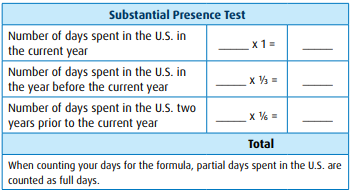If you plan to spend your winters in the U.S., you should be concerned with more than just ensuring your passport is up-to-date and that your bags are packed. Snowbirds – Canadian residents who spend part of each year in the United States – need to be aware of the potential liability to pay U.S. income tax on the same basis as a permanent U.S. resident.
U.S. citizens and Green Card holders must pay U.S. taxes on their worldwide income, regardless of their country of residence. Even though snowbirds only visit the U.S. for the winter months, there is the potential that they can be considered U.S. residents for income tax purposes, and, in certain circumstances, they may be taxed in the U.S. on their worldwide income.
Counting days in the U.S.
If you are not a Green Card holder or a U.S. citizen, you may still be considered to be a resident for U.S. tax purposes if you were present in the U.S. for more than 30 days in the current year and meet the Substantial Presence Test outlined below.

If the total number of days spent in the U.S. from the test exceeds 182 days, you have met the Substantial Presence Test and you may be subject to U.S. tax on your worldwide income. However, if you were present in the U.S. for less than 183 days in the current year, you may be eligible to claim the Closer Connection Exception (explained below) and avoid being considered a U.S. resident for U.S. tax purposes.
Since the Substantial Presence Test calculation considers days (including partial days) of presence in the U.S. during the current and the two preceding years, it is important that you keep a record of the number of these days you were physically present in the U.S. during each calendar year.
Closer Connection Exception
If you have met the Substantial Presence Test, you are considered to be a U.S. resident alien and be required to file a U.S. individual income tax return (Form 1040) to report your worldwide income. However, if you were present in the U.S. for less than 183 days during the current year and can demonstrate that you have a closer connection to Canada than the U.S., you may be able to claim a Closer Connection Exception and be treated as a non-resident of the U.S. The Internal Revenue Service (“IRS”) will consider the following factors in their determination of a Close Connection Exemption:
-
location of permanent home;
-
location of family;
-
location of personal belongings;
-
country where your driver’s licence was issued;
-
country of residence listed on official documents; and
-
country where you are deriving the majority of your income in the current year
To claim the Closer Connection Exception, you must file Form 8840, with the IRS by the June 15 filing deadline (assuming you did not earn wages as a U.S. employee).
Canada-U.S. Income Tax Treaty Tie-Breaker Rules
If you are present in the U.S. more than 182 days in the current year, you will not be eligible for the Closer Connection Exception and are considered to be a U.S. resident for tax purposes under U.S. tax law. However, if you are also considered to be a tax resident of Canada, you may be able to claim that you are a non-resident of the U.S. by applying the Canada U.S. Income Tax Treaty Tie-Breaker Rules (“Tie-Breaker Rules”). If you maintain a permanent home in Canada and your personal and economic ties are closer to Canada than the U.S., you would likely be considered to be a non-resident of the U.S. under the treaty Tie-Breaker Rules.
Consult a tax professional before you fly south
As the tax filing requirements and residency determination can be complex, it is important that you consult with a professional tax advisor experienced in cross-border taxation to ensure that you are complying with all your tax obligations south of the border.
For more information, please speak with your BMO financial professional.
BMO Private Wealth provides this publication for informational purposes only and it is not and should not be construed as professional advice to any individual. The information contained in this publication is based on material believed to be reliable at the time of publication, but BMO Private Wealth cannot guarantee the information is accurate or complete. Individuals should contact their BMO representative for professional advice regarding their personal circumstances and/or financial position. The comments included in this publication are not intended to be a definitive analysis of tax applicability or trust and estates law. The comments are general in nature and professional advice regarding an individual’s particular tax position should be obtained in respect of any person’s specific circumstances.
BMO Private Wealth is a brand name for a business group consisting of Bank of Montreal and certain of its affiliates in providing private wealth management products and services. Not all products and services are offered by all legal entities within BMO Private Wealth. Banking services are offered through Bank of Montreal. Investment management, wealth planning, tax planning, and philanthropy planning services are offered through BMO Nesbitt Burns Inc. and BMO Private Investment Counsel Inc. If you are already a client of BMO Nesbitt Burns Inc., please contact your Investment Advisor for more information. Estate, trust, and custodial services are offered through BMO Trust Company. BMO Private Wealth legal entities do not offer tax advice. BMO Trust Company and BMO Bank of Montreal are Members of CDIC.
® Registered trademark of Bank of Montreal, used under license.
All rights are reserved. No part of this publication may be reproduced in any form, or referred to in any other publication, without the express written permission of BMO Private Wealth.